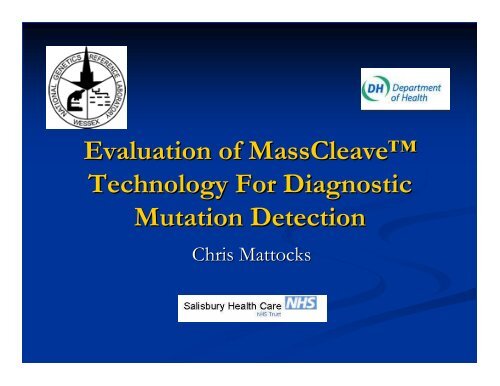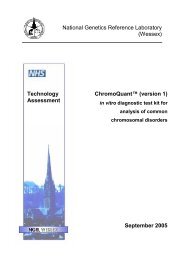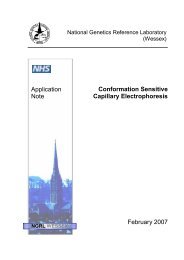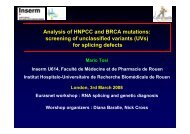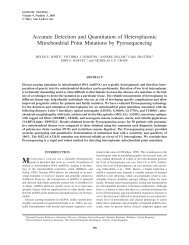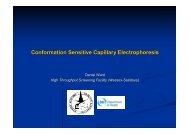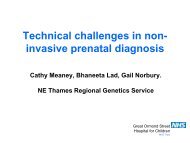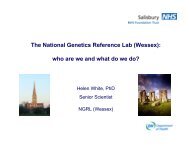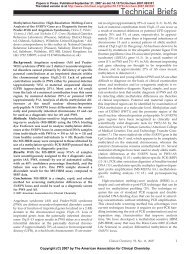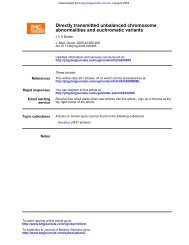Evaluation of MassCleave™ Technology For Diagnostic Mutation ...
Evaluation of MassCleave™ Technology For Diagnostic Mutation ...
Evaluation of MassCleave™ Technology For Diagnostic Mutation ...
Create successful ePaper yourself
Turn your PDF publications into a flip-book with our unique Google optimized e-Paper software.
<strong>Evaluation</strong> <strong>of</strong> MassCleave<br />
MassCleave<br />
<strong>Technology</strong> <strong>For</strong> <strong>Diagnostic</strong><br />
<strong>Mutation</strong> Detection<br />
Chris Mattocks
PCR<br />
T7-<br />
MassCleave MassCleave<br />
chemistry<br />
Universal forward primer<br />
with T7 promoter tag<br />
C specific<br />
cleavage product<br />
<strong>For</strong>ward transcription<br />
with T7 promoter<br />
U specific<br />
cleavage product<br />
C specific<br />
cleavage product<br />
Reverse transcription<br />
with T7 promoter<br />
Mass spectrometry and comparison to predicted patterns<br />
Universal reverse primer<br />
with T7 promoter tag -T7<br />
U specific<br />
cleavage product<br />
Ref: A strategy for the rapid discovery <strong>of</strong> disease markers using the MassARRAY system.<br />
Rodi CP, Darnh<strong>of</strong>er-Patel B, Stanssens P, Zabeau M, van den Boom D. Biotechniques. 2002 Jun;Suppl:62-6, 68-9.
MassCleave MassCleave<br />
<strong>Evaluation</strong><br />
�� Existing PCR designs<br />
�� 12 fragments x 15 samples each + H 2O O control<br />
�� Plate 1:<br />
�� BRCA1 exon 11 - 6 fragments (B,C,G,J,K,L)<br />
�� Plate 2:<br />
�� hMLH1 – 5 fragments (exons ( exons 2,4,12,13 & 16)<br />
�� MSH2 – exon 15 only<br />
�� Sequenom provided primers<br />
�� Amplifications carried out in NGRL<br />
�� Analysis carried out by Sequenom
<strong>Mutation</strong><br />
type<br />
Insertion<br />
Deletion<br />
Het. point<br />
Hom. point<br />
Total<br />
Seq.<br />
results<br />
5<br />
32<br />
34<br />
60<br />
131<br />
BRCA1 Results<br />
flagged<br />
4<br />
26<br />
34<br />
60<br />
126<br />
<strong>Mutation</strong>s identified with MassCLEAVE<br />
(SNP discovery s<strong>of</strong>tware aided analysis)<br />
missed<br />
1*<br />
6*<br />
0<br />
0<br />
7*<br />
False<br />
+ve<br />
7<br />
1<br />
0<br />
0<br />
8+1 #<br />
position<br />
0<br />
15<br />
20<br />
45<br />
80<br />
nature<br />
*retrospective inspection <strong>of</strong> spectra clearly displays the mutation identifying signals<br />
#one unclassified variant was called in a normal sample.<br />
2<br />
7<br />
34<br />
60<br />
103<br />
Zygosity<br />
hom/het<br />
3<br />
26<br />
34<br />
60<br />
123
<strong>Mutation</strong><br />
type<br />
Insertion<br />
Deletion<br />
Het. point<br />
Hom. point<br />
Total<br />
hMLH1 &hMSH2 Results<br />
Seq.<br />
results<br />
5<br />
12<br />
25+1 #<br />
4<br />
46+1 #<br />
flagged<br />
4<br />
10<br />
25+1 #<br />
4<br />
44+1 #<br />
<strong>Mutation</strong>s identified with MassCLEAVE<br />
(SNP discovery s<strong>of</strong>tware aided analysis)<br />
missed<br />
0<br />
2*<br />
0<br />
0<br />
2*<br />
False<br />
+ve<br />
0<br />
0<br />
0<br />
0<br />
0<br />
position<br />
4<br />
1<br />
25+1 #<br />
4<br />
34+1 #<br />
nature<br />
4<br />
1<br />
25<br />
4<br />
34<br />
Zygosity<br />
hom/het<br />
5<br />
8<br />
25+1 #<br />
3<br />
41+1 #<br />
*retrospective inspection <strong>of</strong> spectra clearly displays the mutation identifying signals.<br />
#two base pair substitution, AA>GC
Rxn<br />
TR<br />
TR<br />
CR<br />
CR<br />
mass<br />
4918<br />
5247<br />
1689<br />
2018<br />
Theoretical cleavage<br />
Relative<br />
frequency<br />
in normal<br />
1<br />
0<br />
1<br />
0<br />
Relative<br />
frequency<br />
in mutant<br />
0.5<br />
0.5<br />
0.5<br />
0.5<br />
GAAAACGGAGCAAAT<br />
GAAAACAGGAGCAAAT<br />
GGAGC<br />
AGGAGC<br />
Sequence
Frameshifts not flagged<br />
�� 3819 del GTAAA base 154 to 158 fragment K - 3/3 missed<br />
�� Only 1 additional signal (within normal analysis range)<br />
�� V. Low potential score<br />
�� S<strong>of</strong>tware not currently designed to detect 5 bp deletions<br />
Rxn<br />
TF<br />
CF<br />
CF<br />
CR<br />
mass<br />
1658<br />
6747<br />
5110<br />
1566<br />
Relative<br />
frequency<br />
in normal<br />
1<br />
1<br />
0<br />
2<br />
Relative<br />
frequency<br />
in mutant<br />
0.5<br />
0.5<br />
0.5<br />
1.5<br />
AAAGT<br />
TTGTTATTTGGTAAAGTAAAC<br />
TTGTTATTTGGTAAAC<br />
TTTAC<br />
Sequence
3819 del GTAAA C-froward C froward
Frameshifts not flagged<br />
�� 4184 del TCAA base 231-234 231 234 fragment L – 2/9 missed<br />
�� Close proximity <strong>of</strong> 2 nd mutation<br />
�� Only T-forward T forward gives unambiguous signals<br />
�� Both amplicons failed/poor quality in T-forward T forward<br />
�� T rich fragment in C-reverse C reverse<br />
Rxn<br />
TF<br />
TF<br />
CF<br />
CF<br />
CF<br />
CR<br />
CR<br />
mass<br />
5520<br />
5247<br />
2990<br />
5210<br />
6913*<br />
3761<br />
2479<br />
Relative<br />
frequency<br />
in normal<br />
1<br />
0<br />
1<br />
1<br />
0<br />
1<br />
0<br />
Relative<br />
frequency<br />
in mutant<br />
0.5<br />
0.5<br />
0.5<br />
0.5<br />
0.5<br />
0.5<br />
0.5<br />
CAAGAAGAACAAAGCAT<br />
AAGAAGAACAAAGCAT<br />
AAGAAGAAC<br />
TTGGAAGAAAATAATC<br />
TTGGAAGAAAATAAGAAGAAC<br />
TTGATTATTTTC<br />
TTATTTTC<br />
Sequence
Frameshifts Misscalled<br />
�� 2731 ins T base 294 fragment G – miss-called miss called as 2731<br />
C>T hom<br />
�� Can only be discriminated by T-reverse T reverse and C-reverse C reverse<br />
�� Presence second mutation<br />
�� De-convoluted De convoluted in retrospect
2731 ins T T-reverse T reverse
Frameshifts Misscalled<br />
�� 3450 del CAAG base 154 to 157 fragment J<br />
�� Only T-forward T forward informative<br />
�� Confounding noise (also seen in another sample)<br />
�� Indicator seen in retrospect
3450 del CAAG T-forward T forward
Point mutations miss-located<br />
miss located<br />
�� 14 hets (3 unique)<br />
�� 11 in fragments with 3 mutations<br />
�� 2 in fragments with 2 mutations<br />
�� 1 in fragment with 1 mutation<br />
�� 15 Hom (1 mutation – 15/15 cases)<br />
�� One <strong>of</strong> calls correct
Summary<br />
�� Design non-optimal non optimal<br />
�� All point mutations flagged and called but<br />
position occasionally ambiguous<br />
�� 32/37 frameshifts flagged – only 2 unique<br />
mutations missed<br />
�� 2 frameshifts misscalled - would need<br />
confirmatory sequencing regardless
Conclusions<br />
�� MassCleave MassCleave<br />
provides:<br />
�� Fast sample turn around<br />
�� Very low false positive rate<br />
�� Very promising comparative re-sequencing re sequencing method<br />
for diagnostic screening<br />
�� But:<br />
�� More stringent (objective) quality criteria plus<br />
extension <strong>of</strong> data analysis range needed
�� Larger study<br />
Further work<br />
�� Optimal design<br />
�� Reference mutation controls<br />
�� Defined quality criteria<br />
�� Cost analysis<br />
�� S<strong>of</strong>tware development<br />
�� Mulitple alignments?<br />
�� Frameshifts? Frameshifts<br />
�� Work in progress by Sequenom
Acknowledgements<br />
NGRL (Wessex)<br />
Helen White<br />
Niels Storm<br />
Susan Muller
Preliminary report<br />
available at http://www.ngrl.co.uk/Wessex/maldi_t<strong>of</strong>.htm<br />
http:// www.ngrl.co.uk/Wessex/maldi_t<strong>of</strong>.htm


